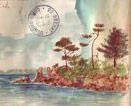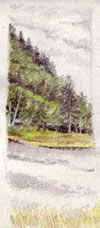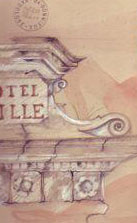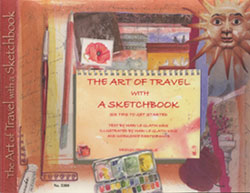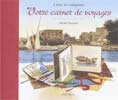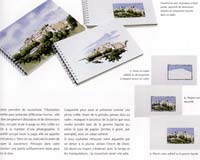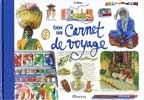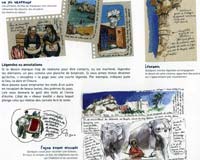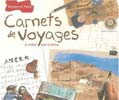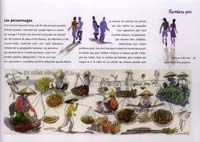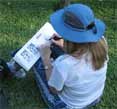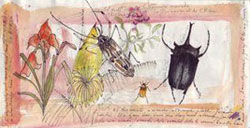
Mari's Costa Rica Sketchbook
After recently reading the new book The Art of Travel With a Sketchbook I wanted to know more about the author, Mari Le Glatin-Keis. I was fortunate to be able to correspond with her by both email and phone, and discovered that she is very enthusiastic about the joys of travel sketching.

Mari
Sketching
Martha: What kind of sketching do you for your own enjoyment?
Mari: Sketching is amazing, isn’t it? I find myself sketching whenever I travel; everything I see stimulates me to record. My sketchbook pages are all I have to carry memories, as I don’t take photographs. At home, I don’t sketch every day but I always carry a small sketchbook and pencil on my walks and bicycle rides. Even if I do not use them I like to have them on hand. When I don’t have my sketchbook, I sketch with my eyes; I literally use my eyes as if they were pens or brushes.
- 6 x 8 inch Pentalic sketchbook, not too small, not too big
- 0.7 mechanical pencil
- small watercolor set, a kid’s set or whatever is on hand
- 2 brushes, one big and one small
- a few color pencils and pastels
- glue stick
Voila: the simpler, the lighter, the better!
I have always been a sketcher and a traveler. I met my husband Dick in Ecuador 30 years ago when I was making my way through South America sketching plants and flowers. Back then sketching was already my life and expression, my “raison d’être” as I moved deep through the Andes and the Amazon, amongst the local people. Sadly, I later lost those four years of recordings in a shipwreck in 1978 (another long story!) and that was that. It was my first big lesson in “letting go” and about the ephemeral side of life.
I wanted to tell people how sketching can save your life as it saved mine! Sketchbooks are more valuable than any finished piece to be hung on a wall as they contain your first emotions and your own interpretation of a moment or a situation. When sketching we are open to the world outside us, we forget about pains and worries, and are totally in the moment.
I also wanted to encourage people to have a deeper travel experience by observing cultural details and local people more closely. In many countries traveling with a sketchbook will set you apart from a regular tourist. Often I remind my participants that if traveling with a sketchbook is about recording life as it is, wherever we are, then we should allow our pages to reflect what we see. For example, when I look at my many sketchbooks from Oaxaca in the eight years I went there, I can see what was coming. The tension, the increasing contrast between the rich and the poor, it is all there in my pages.
Although I have created other books, this was the first time I had to write the full text as well as illustrate. This was a new challenge, especially since English is not my first language. Making the entire book took a year and a half of intense work. I even created pages in my sleep!
But the real hardship came when the designer asked me put my mockup on the computer. Until then, when laying out pages for a book I manually cut and pasted the pages and I loved that process. Layout on the computer was very different. A friend and workshop participant, Dianne Roth, saved me when she volunteered to help me transfer my hard copy onto the computer.
In workshops I see people re-discovering the “child” in themselves and playing, and I always feel privileged to witness their transformation. I am totally amazed by their spontaneity as, without any hesitation, they lay down the most innocent lines in their sketchbooks. I often envy my participants for their pure and spontaneous renderings: I am still trying to let go of the heavy training I received in art school!
Meanwhile, I was sending my sketchbooks to French publishers. In 1999, Equinoxe offered me a contract to publish my travel sketchbooks: a dream come true! Four sketchbooks that I had already created, with no publication in mind at the time, were published as books. A fifth sketchbook, Balades a travers l’Armor et l’Argoat, was a new assignment.
I also created a daybook, Mon Jardin Jour après Jour, in 2001. Day after day I went out in my small garden here in Oregon, a sketchbook in one hand and a pencil in the other, and I recorded all the changes I saw throughout the year. I loved the process of creating that book!
It was seeing more and more of these “beautiful” art travel books on the shelves, and remembering the real miracle of the expression taking place over and over right in front of my eyes during workshops that motivated me to write my new book. I knew I had to tell people that if they wanted to sketch too, they could!
You do not learn “how to” sketch, you sketch. In travel sketching there is no right or wrong, no rules or recipes. Words, lines, colors, collage: use anything you have on hand to express yourself. In sketching it seems like the less technique you know the better you are. Many of us have to gain confidence in ourselves before learning skills. It is all about trusting. If we put our expectations and our critical mind aside, beauty will come through.
I’ve created three workshops in the Pacific Northwest for next year, each in a unique environment. Wherever we are there is culture and beauty to record in our sketchbooks and I am really happy to develop such workshops here in the US.
Nevertheless, I keep going back to the two regions of France I know best: Brittany, where I grew up, and Provence, where I lived from 1992-94. In 2009, I will add Le Lot to my destinations. It is a part of France that I have been discovering over the years and I feel I know enough of the region now to share its wonders with my participants.
I am also about to travel to Mexico to make final plans for a workshop there in 2008 as well.
Each trip is not only a sketching workshop but a voyage through cultures and peoples on which I am able share my friends, food and culture with my participants.
In her book’s introduction Mari says: “This book is a humble statement with no pretensions, written from my heart”. Her enthusiasm for sketching and sincere desire to share it with others is contagious, and I can see that this book was done as a Labor of Love. It was a true joy to talk with Mari and I hope I”ll get to attend one of those workshops soon!
For More Information:
Book Review: The Art of Travel With a Sketchbook
About Mari Le Glatin-Keis
Mari’s 2008 Workshops
❀ ❀ ❀

